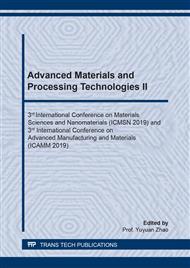p.39
p.51
p.59
p.67
p.75
p.85
p.92
p.98
p.106
GLARE Hydro-Mechanical Deep Drawing Analysis Based on the Forming Depth
Abstract:
The Fiber metal laminates (FMLs) combine the advantages of fiber-reinforced polymer properties, like stiffness and strength, with metallic alloys, like toughness and durability. These hybrid materials can unravel some problems in the industrial sector, particularly in aerospace, and advanced automotive industry. Still, there are significant challenges in the GLARE sheets forming process even for small drawing ratios, notably smaller and complex-shaped fiber metal laminate with low thickness. As a case study, a cylindrical GLARE cup was chosen. This shape with sharp bends and vertical geometrical features, still face many challenges and difficulties in the forming process. Numerical simulations have been used utilizing ABAQUS and compared with the experimental results in the Hydro-mechanical deep drawing to achieve good forming quality with higher depth. An extensive investigation of the effect of process variables has been done such as cavity pressure, blank holding force, and blank diameter. Also, their roles in wrinkles formation, tearing and thinning, and formability has been performed. Furthermore, the friction in two cases; cured, and semi-cured condition, has been considered. The results show that the application of cavity pressure within specified limits has a positive effect on the quality of the formed cup and leads to higher depths. The same conclusion for the blank holder, which has a positive impact on wrinkling elimination and friction reducing between the aluminum layers and the fiberglass. The result shows that the semi-cured condition of the GLARE has a good effect on wrinkling reduction, due to the uniform movement of the fiberglass inside the aluminum layers. Understanding these parameters and the GLARE forming behavior and have a good selection of these parameters can give the advantage to achieve smaller and more complex shapes with higher depth, particularly for mass production. Finally, this study can extend the industrial application areas of FMLs and GLARE parts.
Info:
Periodical:
Pages:
75-84
Citation:
Online since:
March 2020
Authors:
Keywords:
Price:
Сopyright:
© 2020 Trans Tech Publications Ltd. All Rights Reserved
Share:
Citation:


